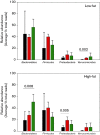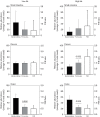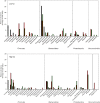Bacterial communities in the small intestine respond differently to those in the caecum and colon in mice fed low- and high-fat diets
- PMID: 28742010
- PMCID: PMC5775896
- DOI: 10.1099/mic.0.000496
Bacterial communities in the small intestine respond differently to those in the caecum and colon in mice fed low- and high-fat diets
Abstract
Bacterial communities in the mouse caecum and faeces are known to be altered by changes in dietary fat. The microbiota of the mouse small intestine, by contrast, has not been extensively profiled and it is unclear whether small intestinal bacterial communities shift with dietary fat levels. We compared the microbiota in the small intestine, caecum and colon in mice fed a low-fat (LF) or high-fat (HF) diet using 16S rRNA gene sequencing. The relative abundance of major phyla in the small intestine, Bacteriodetes, Firmicutes and Proteobacteria, was similar to that in the caecum and colon; the relative abundance of Verrucomicrobia was significantly reduced in the small intestine compared to the large intestine. Several genera were uniquely detected in the small intestine and included the aerotolerant anaerobe, Lactobacillus spp. The most abundant genera in the small intestine were accounted for by anaerobic bacteria and were identical to those identified in the large intestine. An HF diet was associated with significant weight gain and adiposity and with changes in the bacterial communities throughout the intestine, with changes in the small intestine differing from those in the caecum and colon. Prominent Gram-negative bacteria including genera of the phylum Bacteroidetes and a genus of Proteobacteria significantly changed in the large intestine. The mechanistic links between these changes and the development of obesity, perhaps involving metabolic endotoxemia, remain to be determined.
Conflict of interest statement
The authors declare that there are no conflicts of interest.
Figures



References
Publication types
MeSH terms
Substances
Grants and funding
LinkOut - more resources
Full Text Sources
Other Literature Sources
Medical
Research Materials
Miscellaneous

